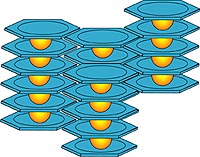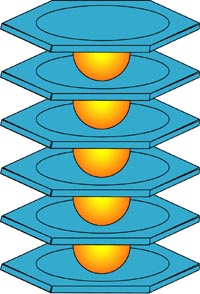| Media Center |  |
Sandwich clusters may improve magnetic memory storageARGONNE, Ill. (Nov. 11, 2004) – A new type of molecular magnet known as a “sandwich cluster” is being studied under a joint research collaboration between the U.S. Department of Energy's Argonne National Laboratory, the University of Chicago and Keio University in Japan. These molecular magnets could be useful for magnetic storage or spintronics, developing technologies that could enable computers to have ultra-small storage capabilities with faster and more energy-efficient systems. The three collaborating institutions have been funded by the Japan Science and Technology Agency to explore the magnetic properties of these newly found molecules. Argonne has received $93,800 this year to focus on the magnetic properties of these clusters and to work on developing techniques to deposit the clusters onto surfaces. Argonne expects to receive additional funding through fiscal year 2007. Argonne is an excellent place to study these clusters, as it houses the rare Stern-Gerlach molecular beam deflection apparatus. Only three of these devices exist in the world, and Argonne is home to the only one at a U.S. national laboratory. The Stern-Gerlach apparatus contains a special magnet that generates small deflections in a molecular beam of metal clusters that travel inside a high vacuum chamber. “We can determine how interesting these magnetic clusters are with the molecular beam deflection apparatus,” says Argonne chemist Mark Knickelbein. “From the magnitude of the deflections, we can determine the ‘magnetic moments' of the clusters—the most fundamental measure of their magnetism.” A “sandwich cluster” is a molecule consisting of alternating layers of metal atoms and organic molecules, such as vanadium and benzene. These clusters can be several nanometers (billionths of a meter) in length, depending on the number of layers in the cluster, which in turn depends on the types of metal atoms and organic molecules used and the temperature of the atoms and molecules at creation. The clusters display different magnetic behaviors than regular bulk metals. Argonne has already made several advances in sandwich-cluster research. For example, researchers have discovered how to generate clusters larger than ever observed before by reacting laser-generated metal atoms with benzene and other molecules at low temperatures. The other lead researchers on the project, in addition to Argonne's Knickelbein, are professor Steve Sibener of the University of Chicago and professor Atsushi Nakajima of Keio University. The combined effort among the three institutions allows advanced research on the development of the new molecular magnets, which may be valuable candidates for magnetic storage and spintronics. — Raquel Harper The nation's first national laboratory, Argonne National Laboratory conducts basic and applied scientific research across a wide spectrum of disciplines, ranging from high-energy physics to climatology and biotechnology. Since 1990, Argonne has worked with more than 600 companies and numerous federal agencies and other organizations to help advance America's scientific leadership and prepare the nation for the future. Argonne is operated by the University of Chicago for the U.S. Department of Energy's Office of Science. For more information, please contact Catherine Foster (630/252-5580 or media@anl.gov) at Argonne. |
|
||||||
|
||||

